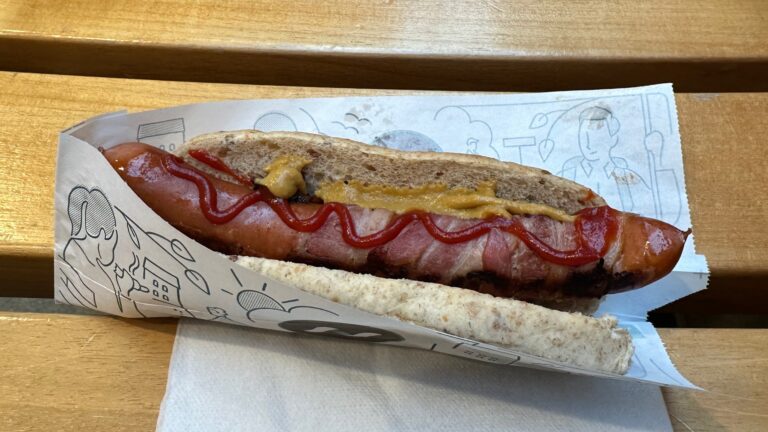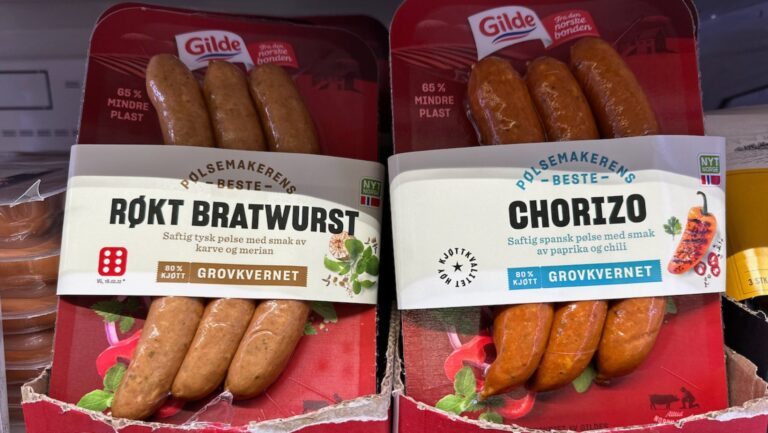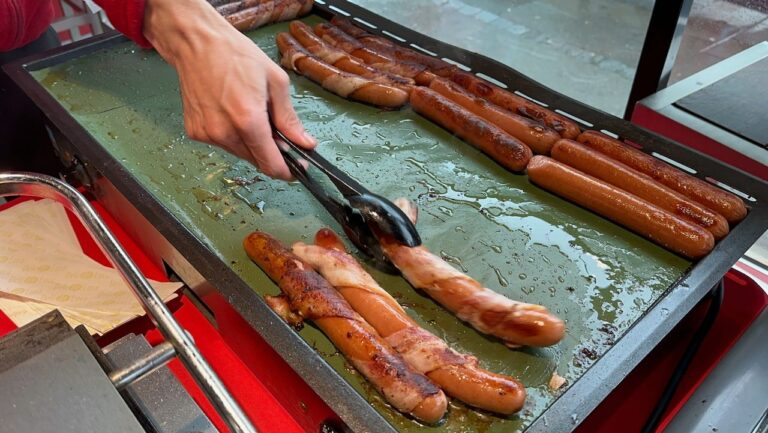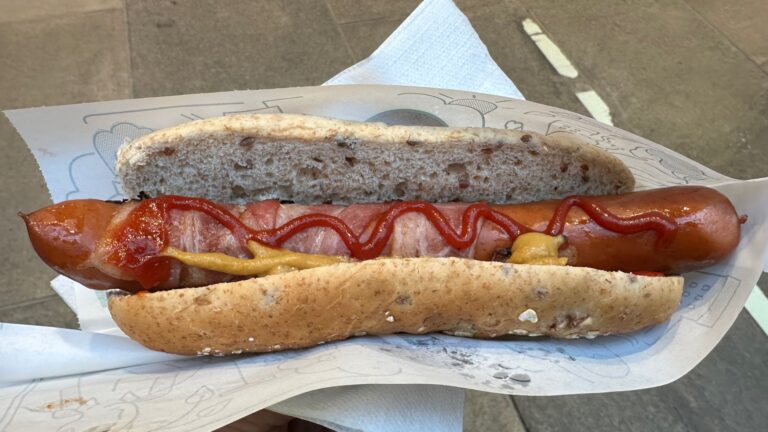Grilled, steamed or boiled, the pølse–Norway’s take on the hot dog–is an incredibly popular snack. If you’ve spent any time in the country, you’ve probably noticed this.
But have you ever wondered why this simple dish has such a special place in the hearts (and stomachs) of Norwegians?

Let's take a playful journey into everything pølse: where to find the best ones, the unique flavours and ingredients that set them apart, the types of bread they nestle in, and the array of toppings that can turn a simple snack into a gourmet experience.
And of course, we'll explore why these tasty treats have become such a cultural icon, beloved by most Norwegians. So, grab your mustard and ketchup, and let's embark on a tasty adventure in the world of Norway's pølse!
Introducing the pølse
The Norwegian word pølse translates literally as “sausage”, but in most cases it refers to the humble hot dog – certainly when there is no other context to specify a particular type of sausage.
Sausages have been around in Norway since the Middle Ages, but hot dogs became an established staple around the 1950s.
During this period, post-war Europe was rebuilding and redefining itself, and American goods and cultural values were flowing in. This era saw the introduction and popularisation of American fast food chains, soft drinks, comic books, music, and… hot dogs!
Over time, they became a staple at events and celebrations, particularly on Norway's National Day. Nowadays, the average Norwegian eats 100 pølser a year, which amounts to a staggering half a billion in total for the whole country.
Where you can try a pølse
If you spent any amount of time in Norway, you already know that hot dogs are really not difficult to find.

They are available at all train stations, airports, ferries and camping grounds, in convenience stores such as Narvesen and 7-11, and at sports events (both professional and amateur).
Some towns still have pølseboder; dedicated kiosks specialising in the things. They are a dying breed, but you can still find a pretty good one in Oslo: Syverkiosken.
Farmers’ markets almost always serve pølser, although these would fall more in the “sausage” category as opposed to hot dogs.
If you’re a do-it-yourself kind of person, pølser are one of those things that are available in absolutely all supernarkets in the country.
What Norwegian hot dogs taste like
The pølse retains the original essence of hot dogs, but has been adapted to appeal to Norwegian tastes. This means that to an American, Norwegian hot dogs may seem quite bland in flavour.
Grillpølse
This is the “default hot dog” in Norway. It’s what you’ll get if you order a “pølse” without specifying the type. It contains both pork and beef (exact proportion of either unspecified) and is quite mild in flavour.
Ostepølse
This one is a bit confusing at first. It translates literally as “cheese sausage”, which leads you to imagining a hot dog garnished with cheese. That is also a thing (see our section about toppings) but the ostepølse is something else.
The cheese is embedded in the hot dog itself. And it does not feel like cheese at all. It’s more some sort of foamy, white-ish liquid that does not bring much to the table in terms of flavour.
Baconpølse
This variety is a meat lover's delight – the most flavourful in our list so far, on account of being wrapped in bacon.
It is exactly as expected, essentially the grillpølse mentioned above, but with a slice of bacon twirled all around it. Sometimes the base sausage is one of the others (an ostepølse or a chilipølse for example).

Chilipølse
Another option if the lack of flavour of the grillpølse is a problem for you: the chilipølse. It is essentially the same base hot dog, but with an extra chilli kick. That being said, don’t expect a very significant kick.
Norwegian palates are not overly adventurous when it comes to spiciness, so what you’ll get is a subtle hint of chilli.
Wienerpølse
A nod to the traditional Viennese sausage, the Norwegian wienerpølse is known for its delicate flavour profile – even more tame in flavour than the grillpølse. Part of the reason for the mildness of the flavour is that the typical way to prepare is to boil it.
Another key difference is that the wienerpølse has a casing, which gives it a bit more of a bite and differentiates it from a typical hot dog.
Veganpølse and vegetarpølse
A relative newcomer to the list, these hot dogs, as their names suggest, are meat-free. The “vegan” type is entirely plant-based – using peas, sunflower seeds or soybeans as the main protein ingredient – whereas the “vegetar” ones will use eggs or milk protein.
It’s difficult to say anything about their taste or texture since they tend to vary quite a lot from one brand to the other. But some of them are not far off the mark when it comes to imitating the flavour and texture of the real thing.
Middagspølse
Literally translating as “dinner sausage”, the middagspølse is also known under the not-very-descriptive name kjøttpølse (meat sausage). This is essentially the exact same thing as a grillpølse, only a bit more girthy and shorter.
It’s meant to be eaten for dinner with sides such as potatoes and vegetables. The label often brags about it being skinnfri (literally: skin free, but what it means is without casing).
Norwegian hot dog toppings and sides
If you have read our review of the most common Norwegian pølser, you know by now that we find them quite tame in the flavour department. One way to remediate that is to get fully on board with the available (often quite surprising) toppings.

The first thing you have to decide when ordering a Norwegian hot dog is the type of bread you want. The pølse is either served i brød (in bread) or i lompe (the lompe, pronounced loo-m-puh, is a soft, circular potato-based flatbread).
If you go for bread, some places will ask you if you want fint eller grovt (white or whole wheat). Now that your pølse has a home, it's time to top it with some weird stuff.
Of course you can just go for the normal ketchup and mustard. Norwegian ketchup is much the same as everywhere else.
Norwegian mustard is generally much sweeter and less vinegary than its American counterpart. But there are other topping options – some much more exotic.
A familiar staple in the US, French fried onions (sprøstekt løk) are an extremely popular hot dog topping in Norway. They add a bit of crunch and onion aroma that improve the overall enjoyment.
Raw onions (rå løk) are another common Norwegian hot dog topping. Like their French fried cousins, they add a bit of crunch, but with a much stronger onion flavour.
Sweet relish (agurkmiks) is also widely found at hot dog stands. Agurkmiks translates literally as “cucumber mixture”.
It’s a sweet and sour relish containing cucumber, onions and red bell peppers. It is not wildly different in flavour than the sweet relish you can find on the market in the US.
Potato salad (potetsalat) may already be familiar to you as a natural sausage accompaniment if you’ve been to Germany. There is a big difference though: while German potato salad tends to be tangy and relatively light, Norwegian potato salad is much more creamy.
Shrimp salad (rekesalat): you read that right! Shrimp salad is a common topping on Norwegian hot dogs.
Like Norwegian potato salad, it tends to be quite creamy and has crunch elements provided by the inclusion of various diced vegetables. Think of it as a gas station surf and turf option.
Try it and love it forever – or make a face and never order it again. At the very least it will give you a story to tell.
Finally, there is grated cheese, another way to bring a bit of texture variation to your hot dog ensemble. The cheese used for this is hvitost (white cheese) a very mild, gouda-like cheese.
Have you been to Norway and tasted a pølse? What did you think? Let us know in the comments.


The first thing off the plane at Gardermoen is after customs, we turn left (or follow the smell) for the first wiener in lompe before even leaving the airport. Enough said!
I first came across the Norwegian pølser in late 1950s when I visited Voss with a college friend. Opposite the small hotel (a pensionet) was a cafe which was frequented by the young and which advertised its menu painted on the cafe’s windows. It was also there I met the young woman who was,within a few years, to be come my wife for 60 years. Alas she died a couple of years ago but the memories of that fast food has a place in my heart.
Oh, yes, every single time I go to visit family and friends in Norway, the first thing I eat is pølse med brød (or occasionally i lompe) and I always buy it all for 17 May to make at home (from the excellent Scandi café and online supermarket ‘Scandinavian Kitchen’, based in London’s Great Titchfield St.). I often eat mine with rekesalat (yes, the shrimp salad, but only in Norway because in the UK you only have the option of prawn cocktail and it’s not the same!)
Not had one since I was 18 so made loompe tonight now all I need is my baconpølse